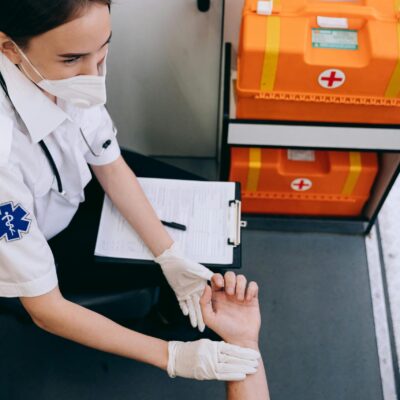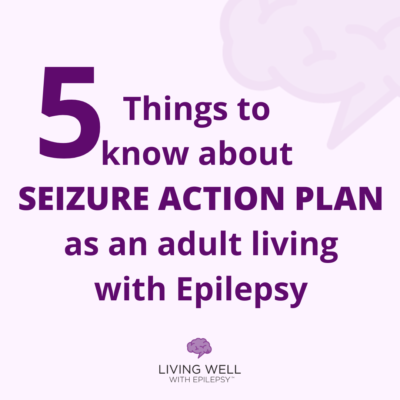
This story is part of the Epilepsy Blog Relay™.
This blog post was submitted by SK Life Science, Inc., the Founding Sponsor of the April 2022 Epilepsy Blog Relay™ and written by Sarah Carlson. Sarah is a real patient acting on behalf of SK life science.
Scroll down for Important Safety Information
SK Life Science, Inc. is an innovative global pharmaceutical company focused on developing treatments for central nervous system disorders. Learn from Sarah Carlson as she shares her journey with epilepsy and message to the epilepsy community to continue advocating for yourself in your fight for seizure freedom.
I Had Seizures on Live TV
As a TV anchor, you become a trusted voice in your community on the most important news. Then imagine that one day your voice is not entirely within your control. That’s what happened to me when I had seizures on live TV. Being unconscious, I don’t remember them. But if I could, I’d rather remember the seizure instead of the moment I regained consciousness. Nothing can allow you to comprehend or be prepared for the “stare” of close friends, family, co-workers and sometimes first responders—looking at me, holding my hand, asking me questions and scared to death. I’d always get a sinking feeling in that moment. “Oh no, not again.” The seizures have happened thousands of times, but, luckily, only a few have ever been caught on TV.
I was 32, and working as a news anchor in Madison, Wisconsin in 2008, when I was officially diagnosed with epilepsy. I suddenly started noticing that things just didn’t feel right. I would feel confused or dizzy while reading the teleprompter on set, but my team told me that I was ok, so I’d keep going. My seizures started out mild, so it took doctors months to diagnose me with epilepsy. It took an additional two years before they were able to find the brain tumor that caused it. Thankfully, the tumor was easy to remove, so I didn’t have to fight cancer. Instead, I had a different fight ahead: a fight for those with epilepsy, myself included.
A Seizure Goes Viral
The worst seizure I experienced occurred shortly after my diagnosis. I collapsed onto my morning show co-anchor during a live taping and had to be rushed to the ER. And while our viewers knew something was wrong, the seizure occurred off-camera, so I was spared from the clip going viral on the internet. However, that didn’t last.
Four years later, some viewers decided to record and post one of my on-camera seizures online. And while my epilepsy was much less severe and much better managed by this point, the emotional toll of the post and users’ comments were brutal. Far too many of the comments suggested I was “evil” because of my seizures. I did my best to ignore it and move on, but the experience opened my eyes to the widespread nature of negative stigma attached to epilepsy. Today, I encourage others to watch the clip to better understand how shocking and horrible it is to experience a seizure, and also to understand how hurtful negative comments and stereotypes made about people living with epilepsy can be. I want those fighting epilepsy to know that there is nothing to hide.
Fighting for Better Seizure Control
One of the things I’ve learned in my journey to better manage my epilepsy is that the hardest part of the fight is controlling seizures; many patients can’t find a medication that works for them. Several doctors told me that if after the first few medications I tried my epilepsy still wasn’t in control, it never would be. I tried about a dozen different medications over the years, many with various side effects. It was my current epileptologist, Dr. Michael Smith at Rush University in Chicago, who was committed to helping me become seizure free. He recommended I take XCOPRI® (cenobamate tablets) CV, which I started on in August 2020. Nearly 12 years after my initial epilepsy diagnosis, I am now seizure free.
Running with Seizures, Not From Them
When my journey with epilepsy started, I was also a newly single mother of two children. I knew I had no other option than to keep moving forward—personally and professionally. I needed to show myself, my children, and my community that epilepsy was not the end. My seizures were unpredictable. Ultimately, they led me to stop working as a news anchor and to give up my driver’s license. Still, I refused to let my seizures define me.
In 2012, I started running marathons, fundraising every year for those with brain tumors as well as epilepsy. I found running to be cathartic, giving me a freedom I didn’t otherwise have. I used to run with a volunteer aid because it wasn’t safe for me to run alone. In 2018, I had three seizures during a race, but my guide still helped me finish in under four hours. She knew my goal was to run with seizures, not from them. Persistence, determination, and hope drove me to cross the finish line. Thanks to the better management of my seizures, I can now run for the cause with a remarkable feeling of independence and peace.
Learn about the steps you can take in your pursuit of zero seizures.
Your epilepsy is unique to you, and seizure treatments work differently from person to person. Like Sarah and other XCOPRI® patients, SK life science encourages people with epilepsy to be their own advocate and stay persistent in their search for the treatment regimen that helps them reach their goals.
If you have epilepsy, know you are not alone in your fight for seizure freedom. Speak with your healthcare provider to learn if XCOPRI® is the right treatment for you.
For more information about XCOPRI®, please visit https://www.xcopri.com/.
IMPORTANT SAFETY INFORMATION AND INDICATION FOR XCOPRI® (cenobamate tablets) CV
DO NOT TAKE XCOPRI IF YOU:
- Are allergic to cenobamate or any of the other ingredients in XCOPRI.
- Have a genetic problem (called Familial Short QT syndrome) that affects the electrical system of the heart.
XCOPRI CAN CAUSE SERIOUS SIDE EFFECTS, INCLUDING:
Allergic reactions: XCOPRI can cause serious skin rash or other serious allergic reactions which may affect organs and other parts of your body like the liver or blood cells. You may or may not have a rash with these types of reactions. Call your healthcare provider right away and go to the nearest emergency room if you have any of the following: swelling of your face, eyes, lips, or tongue, trouble swallowing or breathing, a skin rash, hives, fever, swollen glands, or sore throat that does not go away or comes and goes, painful sores in the mouth or around your eyes, yellowing of your skin or eyes, unusual bruising or bleeding, severe fatigue or weakness, severe muscle pain, frequent infections, or infections that do not go away. Take XCOPRI exactly as your healthcare provider tells you to take it. It is very important to increase your dose of XCOPRI slowly, as instructed by your healthcare provider.
QT shortening: XCOPRI may cause problems with the electrical system of the heart (QT shortening). Call your healthcare provider if you have symptoms of QT shortening including fast heartbeat (heart palpitations) that last a long time or fainting.
Suicidal behavior and ideation: Antiepileptic drugs, including XCOPRI, may cause suicidal thoughts or actions in a very small number of people, about 1 in 500. Call your health care provider right away if you have any of the following symptoms, especially if they are new, worse, or worry you: thoughts about suicide or dying; attempting to commit suicide; new or worse depression, anxiety, or irritability; feeling agitated or restless; panic attacks; trouble sleeping (insomnia); acting aggressive; being angry or violent; acting on dangerous impulses; an extreme increase in activity and talking (mania); or other unusual changes in behavior or mood.
Nervous system problems: XCOPRI may cause problems that affect your nervous system. Symptoms of nervous system problems include: dizziness, trouble walking or with coordination, feeling sleepy and tired, trouble concentrating, remembering, and thinking clearly, and vision problems. Do not drive, operate heavy machinery, or do other dangerous activities until you know how XCOPRI affects you.
Do not drink alcohol or take other medicines that can make you sleepy or dizzy while taking XCOPRI without first talking to your healthcare provider.
DISCONTINUATION:
Do not stop taking XCOPRI without first talking to your healthcare provider. Stopping XCOPRI suddenly can cause serious problems. Stopping seizure medicine suddenly in a patient who has epilepsy can cause seizures that will not stop (status epilepticus).
DRUG INTERACTIONS:
XCOPRI may affect the way other medicines work, and other medicines may affect how XCOPRI works. Do not start or stop other medicines without talking to your healthcare provider. Tell healthcare providers about all the medicines you take, including prescription and over-the-counter medicines, vitamins and herbal supplements.
PREGNANCY AND LACTATION:
XCOPRI may cause your birth control medicine to be less effective. Talk to your health care provider about the best birth control method to use.
Talk to your health care provider if you are pregnant or plan to become pregnant. It is not known if XCOPRI will harm your unborn baby. Tell your healthcare provider right away if you become pregnant while taking XCOPRI. You and your healthcare provider will decide if you should take XCOPRI while you are pregnant. If you become pregnant while taking XCOPRI, talk to your healthcare provider about registering with the North American Antiepileptic Drug (NAAED) Pregnancy Registry. The purpose of this registry is to collect information about the safety of antiepileptic medicine during pregnancy. You can enroll in this registry by calling 1-888-233-2334 or go to www.aedpregnancyregistry.org.
Talk to your health care provider if you are breastfeeding or plan to breastfeed. It is not known if XCOPRI passes into breastmilk. Talk to your healthcare provider about the best way to feed your baby while taking XCOPRI.
COMMON SIDE EFFECTS:
The most common side effects in patients taking XCOPRI include dizziness, sleepiness, headache, double vision, and feeling tired.
These are not all the possible side effects of XCOPRI. Tell your healthcare provider if you have any side effect that bothers you or that does not go away. For more information, ask your healthcare provider or pharmacist. Call your doctor for medical advice about side effects. You may report side effects to FDA at 1-800-FDA-1088 or at http://www.fda.gov/medwatch.
DRUG ABUSE:
XCOPRI is a federally controlled substance (CV) because it can be abused or lead to dependence. Keep XCOPRI in a safe place to prevent misuse and abuse. Selling or giving away XCOPRI may harm others and is against the law.
INDICATION:
XCOPRI is a prescription medicine used to treat partial-onset seizures in adults 18 years of age and older. It is not known if XCOPRI is safe and effective in children under 18 years of age.
Please see additional patient information in the Medication Guide. This information does not take the place of talking with your healthcare provider about your condition or your treatment.
Please see full Prescribing Information and Medication Guide.









Leave a Reply